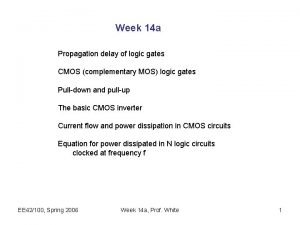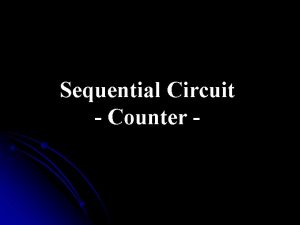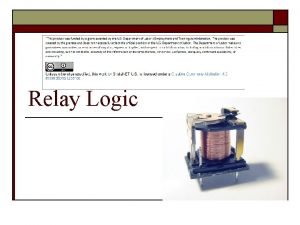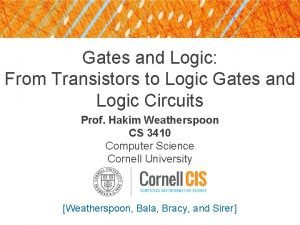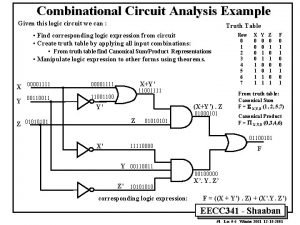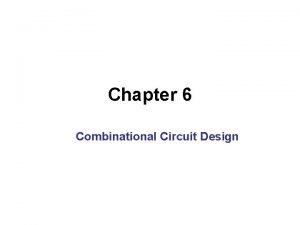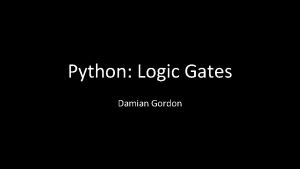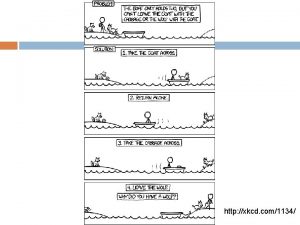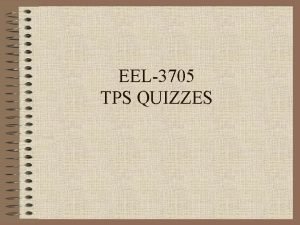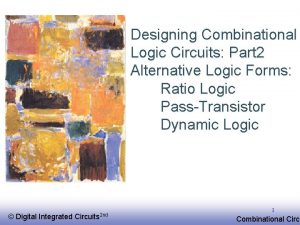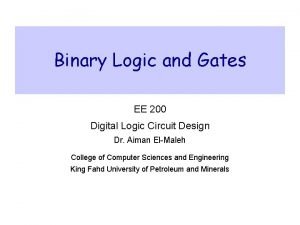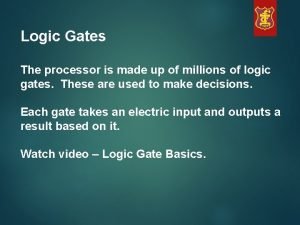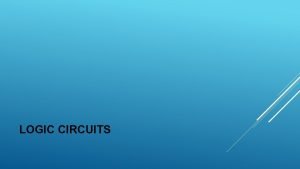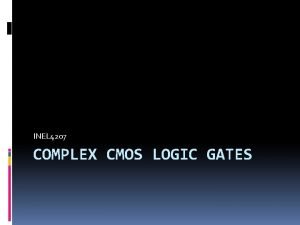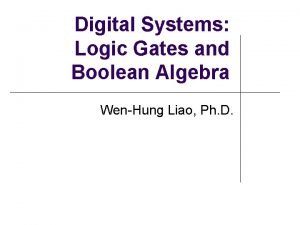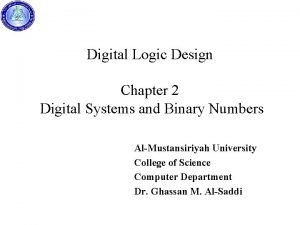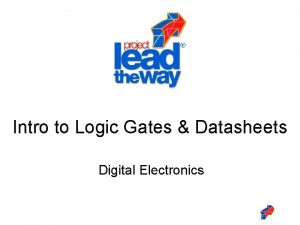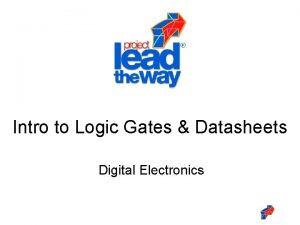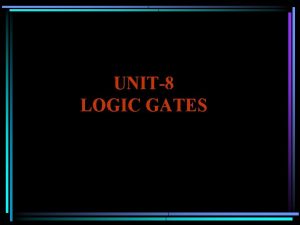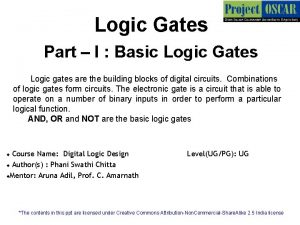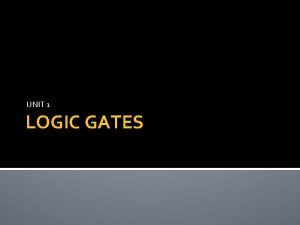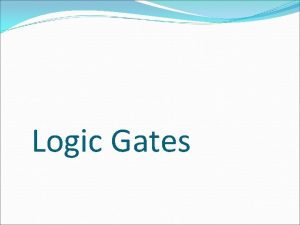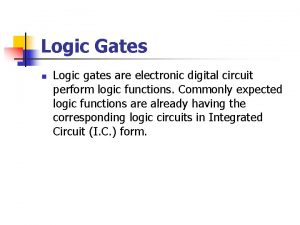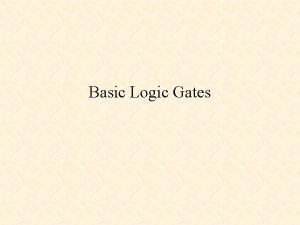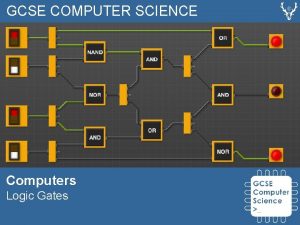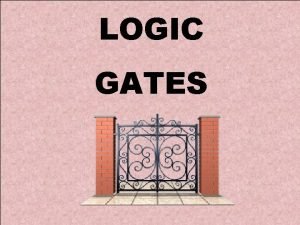Intro to Logic Gates Datasheets Digital Electronics Intro


















- Slides: 18

Intro to Logic Gates & Datasheets Digital Electronics

Intro to Logic Gates & Datasheets This presentation will • Introduce integrated circuits (ICs). • Present an overview of : • Transistor-Transistor Logic – TTL • Complementary Metal Oxide Semiconductor - CMOS • Define the scale of integration and package styles. • Describe the TTL logic gate numbering system. • Review manufacturer datasheets. 2

Introduction to Integrated Circuits • All logic gates are available in Integrated Circuits (ICs) • ICs are categorized in three different ways: – The underlying technology upon which their circuitry is based: • Transistor-Transistor Logic - TTL • Complementary Metal Oxide Semiconductor - CMOS – The scale of integration: • Small Scale Integration - SSI • Medium Scale Integration - MSI • Large Scale Integration - LSI • Very Large Scale Integration - VLSI – Package Style • Through-Hole Technology - THT – Dual Inline Packages - DIP • Surface-Mount Technology - SMT – Small Outline IC - SOIC – Plastic Leaded Chip Carrier - PLCC – Quad Flat Pack - QFP 3

TTL Vs. CMOS Logic TTL: Transistor-Transistor Logic • Constructed from Bipolar Junction Transistors (BJT) • Advantages: BJT Transistor – Faster than CMOS – Not sensitive to damage from electrostatic-discharge • Disadvantages: – Uses more power than CMOS: Complementary Metal Oxide Semiconductor • Constructed from Metal Oxide Semiconductor Field-Effect Transistors (MOSFET) • Advantages: MOSFET Transistor – Uses less power than TTL • Disadvantages: – Slower than TTL – Very sensitive to damage from electrostatic-discharge 4

IC Density of Integration / Complexity SSI: Small-Scale Integration Gates per IC <10 • Logic Gates (AND, OR, NAND, NOR) MSI: Medium-Scale Integration 10 – 100 • Flip Flops • Adders / Counters • Multiplexers & De-multiplexers LSI: Large-Scale Integration 100 – 10, 000 • Small Memory Chips • Programmable Logic Device VLSI: Very Large-Scale Integration 10, 000 – 100, 000 • Large Memory Chips • Complex Programmable Logic Device ULSI: Ultra Large-Scale Integration 100, 000 – 1, 000 • 8 & 16 Bit Microprocessors GSI: Giga-Scale Integration • Pentium IV Processor >1, 000 5

Package Styles Through-Hole Technology Surface Mount Technology (THT) (SMT) DIP: Dual Inline Package SOIC: Small Outline IC QFP: Quad Flat Pack NOTE: For most commercial application, the DIP package has become obsolete. However, it is still the package of choice for educational applications because it can be used with proto-boards. PLCC: Plastic Leaded Chip Carrier 6

Through-Hole Technology (THT) • THT components have pins that are inserted into holes drilled in the PCB and soldered on the reverse side of the board. • Advantages: – Designs with THT components are easier to handassemble than SMT-based designs because THT components are much larger. – THT components can be used in proto-boards. • Disadvantages: – Designs with THT components are significantly larger than SMT-based designs. – Most high-end electronics components (i. e. , microprocessors) are not available in THT package styles. 7

Surface Mount Technology (SMT) • SMT components are mounted on the surface of the PCB, so no holes need to be drilled. • Primary Advantages: – Designs with SMT components are smaller than THTbased designs because SMT components are significantly smaller and have much higher pin counts than THT components. – Also, SMT components can be mounted on both sides of the PCB. • Primary Disadvantages: – Designs with SMT components are more expensive to manufacture because the process is significantly more sophisticated than THT-based designs. – SMT components can not be used in a proto-boarding. 8

TTL Logic Sub-Families TTL Series Standard TTL Low Power Infix Example Comments none 7404 Original TTL gates. Slowest, uses a lot of power. (obsolete) L 74 L 04 Optimized to consume less power than "Standard". (obsolete) First to utilizes the Schottky transistor. Optimized for speed, 74 S 04 but consumes a lot of power. (obsolete) Faster and lower power consumption than the L & S 74 LS 04 subfamilies. The type that is used throughout this course. Schottky S Low-Power Schottky LS Advanced Schottky AS 74 A S 04 Very fast, uses a lot of power. ALS Very good speed-power 74 ALS 04 ratio. Quite popular member of this family. Advanced Low-Power Schottky 9

TTL Logic Gate Numbering System DM 74 LS 08 N Package Style (i. e. , N=DIP) Logic Function (i. e. , 04 = Inverter, 08 = AND Gate, etc. ) Logic Sub-family (i. e. , LS = Low Power Schottky) 74 -Series TTL Manufacturer • DM = Fairchild Semiconductor • SN = Texas Instruments 10

Manufacturer Datasheets A manufacturer datasheet for a logic gate contains the following information: • General Description • Connection (pin-out) Diagram • Function Table • Operating Conditions • Electrical Characteristics • Switching Characteristics • Physical Dimensions 11

General Description 12

Connection Diagram 13

Function Table 14

Recommended Operating Conditions 15

Electrical Characteristics 16

Switching Characteristics 17

Physical Dimensions 18
 What is propagation delay in logic gates
What is propagation delay in logic gates Parking counter using logic gates
Parking counter using logic gates Relay logic gates
Relay logic gates Logic
Logic Not gate with transistors
Not gate with transistors Logic circuit examples
Logic circuit examples Compound gates in vlsi
Compound gates in vlsi Minecraft and gate
Minecraft and gate Python logic gates
Python logic gates Logic.ly demo
Logic.ly demo Xkcd logic gates
Xkcd logic gates Logic gates truth table quiz
Logic gates truth table quiz Alternative logic gates
Alternative logic gates Logic gates identities
Logic gates identities Processor logic gates
Processor logic gates Application of logic gates in aircraft
Application of logic gates in aircraft Complex cmos logic gates
Complex cmos logic gates Boolean expression for nor gate
Boolean expression for nor gate Logic gates and truth tables
Logic gates and truth tables
